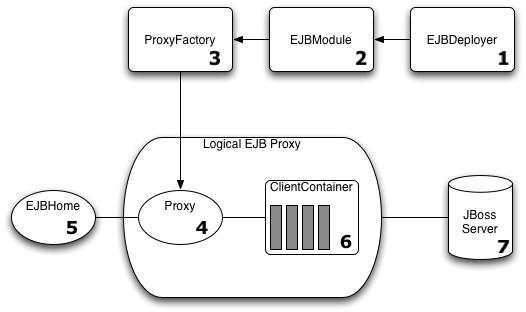We will begin our tour of the EJB container by looking at the client view of an EJB through the home and remote proxies. It is the responsibility of the container provider to generate the javax.ejb.EJBHome and javax.ejb.EJBObject for an EJB implementation. A client never references an EJB bean instance directly, but rather references the EJBHome which implements the bean home interface, and the EJBObject which implements the bean remote interface. Figure 11.1, “The composition of an EJBHome proxy in JBoss.” shows the composition of an EJB home proxy and its relation to the EJB deployment.
The numbered items in the figure are:
-
The EJBDeployer (
org.jboss.ejb.EJBDeployer) is invoked to deploy an EJB JAR. AnEJBModule(org.jboss.ejb.EJBModule) is created to encapsulate the deployment metadata. -
The create phase of the
EJBModulelife cycle creates anEJBProxyFactory(org.jboss.ejb.EJBProxyFactory) that manages the creation of EJB home and remote interface proxies based on theEJBModuleinvoker-proxy-bindingsmetadata. There can be multiple proxy factories associated with an EJB and we will look at how this is defined shortly. -
The
ProxyFactoryconstructs the logical proxies and binds the homes into JNDI. A logical proxy is composed of a dynamicProxy(java.lang.reflect.Proxy), the home interfaces of the EJB that the proxy exposes, theProxyHandler(java.lang.reflect.InvocationHandler) implementation in the form of theClientContainer(org.jboss.proxy.ClientContainer), and the client side interceptors. -
The proxy created by the
EJBProxyFactoryis a standard dynamic proxy. It is a serializable object that proxies the EJB home and remote interfaces as defined in theEJBModulemetadata. The proxy translates requests made through the strongly typed EJB interfaces into a detyped invocation using theClientContainerhandler associated with the proxy. It is the dynamic proxy instance that is bound into JNDI as the EJB home interface that clients lookup. When a client does a lookup of an EJB home, the home proxy is transported into the client VM along with theClientContainerand its interceptors. The use of dynamic proxies avoids the EJB specific compilation step required by many other EJB containers. -
The EJB home interface is declared in the ejb-jar.xml descriptor and available from the EJBModule metadata. A key property of dynamic proxies is that they are seen to implement the interfaces they expose. This is true in the sense of Java's strong type system. A proxy can be cast to any of the home interfaces and reflection on the proxy provides the full details of the interfaces it proxies.
-
The proxy delegates calls made through any of its interfaces to the
ClientContainerhandler. The single method required of the handler is:public Object invoke(Object proxy, Method m, Object[] args) throws Throwable. TheEJBProxyFactorycreates aClientContainerand assigns this as theProxyHandler. TheClientContainer's state consists of anInvocationContext(org.jboss.invocation.InvocationContext) and a chain of interceptors (org.jboss.proxy.Interceptor). TheInvocationContextcontains:-
the JMX
ObjectNameof the EJB container MBean theProxyis associated with -
the
javax.ejb.EJBMetaDatafor the EJB -
the JNDI name of the EJB home interface
-
the transport specific invoker (
org.jboss.invocation.Invoker)
The interceptor chain consists of the functional units that make up the EJB home or remote interface behavior. This is a configurable aspect of an EJB as we will see when we discuss the
jboss.xmldescriptor, and the interceptor makeup is contained in theEJBModulemetadata. Interceptors (org.jboss.proxy.Interceptor) handle the different EJB types, security, transactions and transport. You can add your own interceptors as well. -
-
The transport specific invoker associated with the proxy has an association to the server side detached invoker that handles the transport details of the EJB method invocation. The detached invoker is a JBoss server side component.
The configuration of the client side interceptors is done using the jboss.xml
client-interceptors element. When the ClientContainer invoke method is called it creates an untyped Invocation (org.jboss.invocation.Invocation) to encapsulate request. This is then passed through the interceptor chain. The last interceptor in the chain will be the transport handler that knows how to send the request to the server and obtain the reply, taking care of the transport specific details.
As an example of the client interceptor configuration usage, consider the default stateless session bean configuration found in the server/default/standardjboss.xml descriptor. Example 11.1, “The client-interceptors from the Standard Stateless SessionBean configuration.” shows the stateless-rmi-invoker client interceptors configuration referenced by the Standard Stateless SessionBean.
<invoker-proxy-binding> <name>stateless-rmi-invoker</name> <invoker-mbean>jboss:service=invoker,type=jrmp</invoker-mbean> <proxy-factory>org.jboss.proxy.ejb.ProxyFactory</proxy-factory> <proxy-factory-config> <client-interceptors> <home> <interceptor>org.jboss.proxy.ejb.HomeInterceptor</interceptor> <interceptor>org.jboss.proxy.SecurityInterceptor</interceptor> <interceptor>org.jboss.proxy.TransactionInterceptor</interceptor> <interceptor call-by-value="false"> org.jboss.invocation.InvokerInterceptor </interceptor> <interceptor call-by-value="true"> org.jboss.invocation.MarshallingInvokerInterceptor </interceptor> </home> <bean> <interceptor>org.jboss.proxy.ejb.StatelessSessionInterceptor</interceptor> <interceptor>org.jboss.proxy.SecurityInterceptor</interceptor> <interceptor>org.jboss.proxy.TransactionInterceptor</interceptor> <interceptor call-by-value="false"> org.jboss.invocation.InvokerInterceptor </interceptor> <interceptor call-by-value="true"> org.jboss.invocation.MarshallingInvokerInterceptor </interceptor> </bean> </client-interceptors> </proxy-factory-config> </invoker-proxy-binding>
<container-configuration> <container-name>Standard Stateless SessionBean</container-name> <call-logging>false</call-logging> <invoker-proxy-binding-name>stateless-rmi-invoker</invoker-proxy-binding-name> <!-- ... --> </container-configuration>
Example 11.1. The client-interceptors from the Standard Stateless SessionBean configuration.
This is the client interceptor configuration for stateless session beans that is used in the absence of an EJB JAR META-INF/jboss.xml configuration that overrides these settings. The functionality provided by each client interceptor is:
-
org.jboss.proxy.ejb.HomeInterceptor : handles the
getHomeHandle,getEJBMetaData, and remove methods of theEJBHomeinterface locally in the client VM. Any other methods are propagated to the next interceptor. -
org.jboss.proxy.ejb.StatelessSessionInterceptor : handles the
toString,equals,hashCode,getHandle,getEJBHomeandisIdenticalmethods of theEJBObjectinterface locally in the client VM. Any other methods are propagated to the next interceptor. -
org.jboss.proxy.SecurityInterceptor : associates the current security context with the method invocation for use by other interceptors or the server.
-
org.jboss.proxy.TransactionInterceptor : associates any active transaction with the invocation method invocation for use by other interceptors.
-
org.jboss.invocation.InvokerInterceptor : encapsulates the dispatch of the method invocation to the transport specific invoker. It knows if the client is executing in the same VM as the server and will optimally route the invocation to a reference invoker in this situation. When the client is external to the server VM, this interceptor delegates the invocation to the transport invoker associated with the invocation context. In the case of the Example 11.1, “The client-interceptors from the Standard Stateless SessionBean configuration.” configuration, this would be the invoker stub associated with the
jboss:service=invoker,type=jrmp, theJRMPInvokerservice.org.jboss.invocation.MarshallingInvokerInterceptor : extends the
InvokerInterceptorto not optimize in-VM invocations. This is used to forcecall-by-valuesemantics for method calls.
